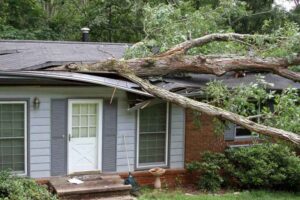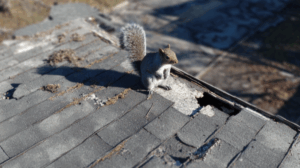If you live in Bethany Beach or anywhere along the Delaware coast, you might think ice dams are only a concern for places with harsh, snowy winters. After all, we don’t exactly get blizzards every week.
But here’s the truth: ice dams can—and do—cause serious roof damage right here in Delaware, even when snow is light. And because they often happen quietly and gradually, homeowners don’t see the effects until water starts seeping through ceilings or staining the walls.
At Grand Exteriors, we’ve seen too many homeowners get blindsided by ice damage they didn’t know they needed to prevent. This post is here to break down the science behind ice dams, explain why they’re a risk in coastal Delaware, and give you practical steps for protecting your home.
What you’ll learn in this blog:
- What ice dams are and how they form—even without heavy snowfall
- Why homes in Bethany Beach and the Delaware coast are especially vulnerable
- Key risk factors like roof design, insulation gaps, and local weather patterns
- Step-by-step strategies to prevent ice dam damage before it starts
- When to upgrade insulation, ventilation, or consider roof replacement
- How Grand Exteriors helps Delaware homeowners stay protected year-round
What is an Ice Dam and Why Does It Matter?
Before we get into prevention, let’s cover the basics. An ice dam is a ridge of ice that forms along the edge of your roof. It happens when snow on the upper part of your roof melts (usually due to heat escaping from your attic), then refreezes at the colder edges near the gutters. That frozen ridge blocks more water from draining, and the water has nowhere to go—except back under your shingles and into your home.
The result? Leaks, wet insulation, mold growth, and expensive repairs.
In places like Bethany Beach, DE, this problem is sneaky. We don’t get deep snow very often, but we do get regular freeze-thaw cycles, especially near the coast. That’s all it takes to create the perfect conditions for ice damming.

Why Delaware Homes Are Still at Risk for Ice Dams
Here’s why ice dams are more common here than most people think:
1. Coastal weather patterns
We often get a light snow followed by a sunny, above-freezing day. That melts snow quickly. Then, nighttime temps dip below freezing, and everything refreezes—especially near roof edges. This cycle repeats and traps water under the snowpack.
2. High humidity
Our coastal air holds more moisture. That contributes to the rapid melting and refreezing process that causes ice dams.
3. Aging roofs and construction
Many homes in Bethany Beach and nearby towns were built before modern insulation and ventilation codes. That allows heat to escape into the attic, warming the roof and speeding up snow melt.
4. Low-slope roof designs
A lot of homes in this area were designed with low or moderate roof pitches, which don’t drain water as quickly—giving ice dams more time to form and cause problems.
Bottom line: even if you’re not shoveling two feet of snow off your driveway, your roof can still be vulnerable.
What to Know Before You Fix or Prevent an Ice Dam
Before we jump into the action steps, it helps to understand what goes into roof ice prevention in our region.
Budget expectations
Some fixes are simple and inexpensive—like adding attic insulation or installing vent baffles. Others, like replacing underlayment or installing de-icing systems, may cost more upfront but can prevent major repairs later.
Know your home’s setup
Do you have enough attic insulation? Are your soffit and ridge vents working? Is your roof more than 15–20 years old? These factors determine what kind of solution will work best.
Understand code recommendations
Delaware’s current code calls for R-49 attic insulation in homes. If your home is older or hasn’t been updated recently, you may be below that—and that contributes to ice dam issues.
You might not need a permit—but check
If you’re making significant roof changes or adding major ventilation, check with your town or contractor. At Grand Exteriors, we handle that process for our customers when permits are needed.
How to Prevent Ice Dams on Roofs in Bethany Beach
You don’t need heavy snow to need a plan. Here’s how to reduce your risk of roof ice damage this winter.
Step 1: Get a professional inspection
We recommend starting with a roof and attic inspection. A trained eye (or better yet, a drone camera) can spot signs of poor ventilation, water stains, missing insulation, or other early warning signs.
Schedule your free inspection with Grand Exteriors.
Step 2: Upgrade your attic insulation
Heat rising into your attic is usually the root cause of snowmelt on the roof. Upgrading to at least R-49 insulation keeps the attic cooler and the roof surface more consistent in temperature. That helps snow stay frozen until it naturally melts away at the right pace.
Step 3: Improve ventilation
Attic ventilation is just as important as insulation. A cold attic keeps snow from melting on the roof deck. Make sure you have:
- Soffit vents bringing in cool air
- Ridge vents allowing warm air to escape
- Gable vents (when appropriate) to support airflow
Step 4: Install ice and water shield underlayment
This is a waterproof membrane installed under the shingles, especially along the edges of the roof and in valleys. If water backs up, the underlayment helps prevent it from getting into your home.
If your roof is older or needs replacement soon, this is a smart upgrade to include.
Step 5: Consider heat cables or gutter protection
These are optional tools, but in the right conditions, they help. Roof heat cables melt snow in targeted areas. Gutter guards prevent debris buildup, so water flows freely and doesn’t get trapped to refreeze.
Why It Pays Off to Take Ice Dam Prevention Seriously
We get it—this might not seem like an urgent issue until the damage is done. But here’s why ice dam prevention is a smart investment in your home.
Different roofing materials, different risks
Some roofs are more prone to ice damage than others.
| Material | Ice Dam Risk | Notes |
| Asphalt Shingles | High | Most common in the area; easily damaged by water backup |
| Metal | Low | Naturally sheds snow, but more expensive upfront |
| Slate/Tile | Medium | Durable, but heavy and harder to modify for ventilation |
If you’re thinking about a new roof, ask us about systems that include ice shields, ventilation upgrades, and long-term warranties.
Lower energy bills
Improving insulation and sealing leaks doesn’t just prevent ice dams—it helps keep your home warmer in winter and cooler in summer. Many homeowners save up to 15% on heating and cooling costs just by sealing the attic properly.
Protects your interior
Water from ice dams doesn’t stay in the attic—it finds its way into drywall, insulation, and electrical systems. Repairs can be costly and time-consuming.
At Grand Exteriors, we design roofing systems that factor in the way Delaware’s coastal winters behave—because we live and work here too. We install ice and water shield on every full roof replacement, and we don’t cut corners on ventilation or insulation guidance.

Common Ice Dam Questions from Homeowners in Bethany Beach
If you’re wondering whether your roof is truly at risk—or how to handle a possible ice dam issue—you’re not alone. We get these questions regularly from homeowners across the Delmarva Peninsula, and especially in Bethany Beach, DE. Below are clear, honest answers based on our experience helping local families protect their homes year after year.
Do ice dams really happen in coastal Delaware?
Yes, ice dams do form in coastal Delaware—even without heavy snow. Bethany Beach and surrounding areas experience freeze-thaw cycles that make ice damming possible with as little as one or two inches of snow.
What are the signs that I have an ice dam problem?
Signs that you may have an ice dam problem include icicles along the eaves, ceiling water stains, cold attic drafts, or paint peeling near your roofline. These symptoms often appear after a cold snap or after snow has melted and refrozen along the roof edge.
Does homeowners insurance cover ice dam damage?
Homeowners insurance may cover ice dam damage, but only if the damage is considered sudden and accidental. If the issue was preventable—such as poor insulation or lack of maintenance—it may not be covered under standard policies.
Can heat cables stop ice dams from forming?
Yes, heat cables can help prevent ice dams in specific problem areas, but they work best as part of a complete prevention plan. They’re most effective when combined with proper attic insulation and roof ventilation.
When should I schedule a roof inspection for ice dam prevention?
You should schedule a roof inspection before winter begins and again after any major snow or freeze-thaw event. Regular seasonal inspections can catch insulation or ventilation issues early, before they cause expensive damage.
Can a new roof help prevent future ice dams?
Yes, a new roof can prevent ice dams if it’s installed with proper underlayment, insulation, and ventilation systems. At Grand Exteriors, every new roofing system includes ice and water shields and is designed for Delaware’s specific winter conditions.
Final Thoughts: The Science Is Simple. Prevention Works.
Ice dams don’t care how much snow you get—they care about how your roof handles cold and heat. In Bethany Beach and across Delaware, freeze-thaw cycles are more dangerous than snow accumulation. That’s why so many local homes are at risk, even in winters that seem mild on the surface.
At Grand Exteriors, we don’t just patch roofs—we help homeowners understand what’s happening and fix the root of the problem. If your home has poor insulation, aging shingles, or questionable ventilation, now’s the time to take a closer look.
Schedule a free inspection today, and we’ll help you build a home that’s winter-ready and energy-smart—no matter what the forecast says.




